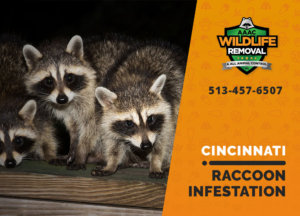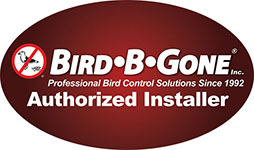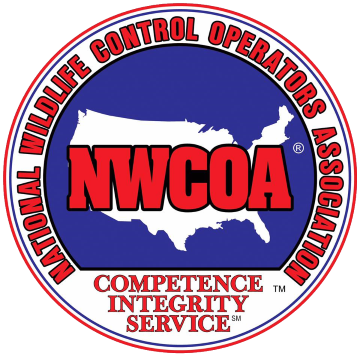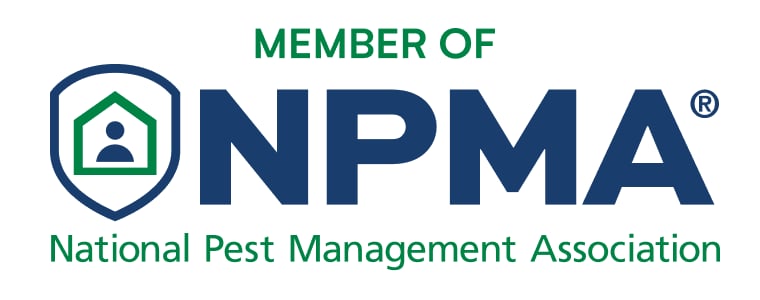
Finding the Raccoon Infestation in Your Home
Alright, let’s start with the basics – how do you know you’ve got raccoons crashing your party? The first step is identifying the telltale signs of a raccoon invasion. These critters are nocturnal, so you might hear them scurrying around your attic or see evidence of their mischievous activities in the morning. Look out for overturned trash cans, raccoon droppings, and those unmistakable claw marks near entry points.
When you spot these signs, it’s time to bring in the cavalry – and by cavalry, I mean the pros at AAAC Wildlife Removal of Cincinnati. Our team of wildlife experts will perform a thorough inspection, pinpointing exactly where and how these raccoons are sneaking into your home. Armed with this knowledge, we’ll set humane traps to safely remove them. Raccoons are clever climbers, often using tree limbs to access rooftops, so trimming back branches near your home can be a proactive step in keeping them out.
But it doesn’t stop there. Raccoons often have a knack for finding their way back. That’s why AAAC Wildlife Removal of Cincinnati employs one-way doors during the trapping process. These doors let the raccoons leave in search of food but prevent them from re-entering your home. It’s a win-win – the raccoons find a new place to call home, and you get your peace and quiet back. AAAC Wildlife Removal will utilize a humane trapping method to bait the raccoons out of your attic. To ensure beyond a shadow of a doubt that all raccoons inside the attic are gone, a one way door might be set up.
Tidying Up
Now that we’ve successfully evicted our uninvited guests, it’s time to tackle the aftermath. Raccoons can leave quite the mess behind, and it’s not something you want to ignore. These critters love to chew and scratch, so don’t be surprised if you find wood scraps and damaged insulation. Unfortunately, their droppings and urine can also pose significant health risks, including the transmission of diseases like Baylisascaris, a nasty roundworm that can cause severe illness in humans.
But don’t worry, AAAC Wildlife Removal of Cincinnati is here to help. Our team specializes in thorough decontamination and cleanup services to ensure your attic or crawl space is safe and sanitary. We’ll remove any contaminated insulation and materials, clean up droppings and urine, and sanitize the area to eliminate any lingering bacteria or parasites. Once the space is clean, we’ll install new, high-quality insulation to restore your home’s energy efficiency and keep it cozy. After all, your home should be a sanctuary for you and your family, not a raccoon playground.
Exclusion Methods
So, we’ve evicted the raccoons and cleaned up the mess – what’s next? Preventing a repeat invasion, of course! Exclusion is all about making your home as uninviting as possible to these furry bandits. The first step is sealing up any potential entry points. This includes repairing holes in your roof, sealing gaps around vents and chimneys, and ensuring that windows and doors close tightly. Don’t forget about those tree limbs, either – trimming them back will make it harder for raccoons to gain access to your roof.
AAAC Wildlife Removal of Cincinnati will conduct a thorough inspection of your home’s exterior, identifying and securing any weak spots. We’ll install heavy-duty materials like steel mesh and metal flashing to reinforce vulnerable areas. Additionally, securing your trash cans with tight-fitting lids and stowing bird feeders can significantly reduce the attractants that draw raccoons to your property in the first place.
For an extra layer of protection, consider installing motion-activated lights. Raccoons are nocturnal and tend to avoid well-lit areas. These lights will startle them and deter them from approaching your home. Another effective deterrent is the use of raccoon repellents, which can be applied around the perimeter of your home to create an invisible barrier that these critters won’t want to cross.
By combining these exclusion methods, you can keep your home raccoon-free and ensure these clever critters find somewhere else to set up camp. Remember, prevention is key – the more proactive you are, the less likely you are to face another raccoon invasion.
Securing Food Sources
One of the main reasons raccoons are attracted to residential areas is the easy access to food. Securing your food sources is crucial in preventing these clever critters from making themselves at home. Start with your trash cans – raccoons are notorious for their dumpster-diving skills. Invest in sturdy, raccoon-proof trash cans with tight-fitting lids. If necessary, use bungee cords or specialized locks to keep the lids securely fastened. Store the trash cans in a garage or shed if possible, especially overnight when raccoons are most active.
Pet food is another major attractant. If you feed your pets outside, make sure to bring in any uneaten food before dusk. Better yet, consider feeding your pets indoors. Store pet food in sealed containers inside your home to prevent raccoons from sniffing it out. Bird feeders can also attract raccoons, who are more than happy to munch on fallen seeds. If you notice raccoon activity, it might be best to temporarily remove bird feeders until the issue is resolved.
In your garden, pick up fallen fruits and vegetables regularly, and consider installing a fence to keep raccoons out. Compost piles should be managed carefully; cover them with a lid or tarp to deter raccoons from digging through them for a midnight snack. By securing all potential food sources, you make your home less appealing to raccoons and reduce the likelihood of an infestation.
Using Deterrents
When it comes to keeping raccoons at bay, a little deterrence can go a long way. Motion-activated lights are an excellent first line of defense. These lights are designed to startle raccoons when they approach, making them think twice about hanging around your property. Install these lights around entry points, such as doorways, garages, and attics, to keep raccoons on their toes.
Sound deterrents can also be effective. Devices that emit high-pitched noises or sudden sounds can scare off raccoons without causing harm. These can be placed in attics, crawl spaces, or other areas where raccoons might try to nest.
Scent repellents are another tool in your arsenal. Raccoons have a strong sense of smell, and certain scents can drive them away. Ammonia-soaked rags or commercial raccoon repellents can be placed around potential entry points to create an invisible barrier. Some homeowners have found success using predator urine (like that of a coyote or fox) to deter raccoons, as it signals danger to these critters.
Physical barriers can also play a crucial role in deterring raccoons. Installing chimney caps, vent covers, and sturdy mesh around crawl space openings can prevent raccoons from finding a way inside. Remember, raccoons are excellent climbers and problem solvers, so ensuring your barriers are robust and well-secured is essential.
By combining these deterrents with exclusion methods and proper food management, you can create a hostile environment for raccoons, encouraging them to find another place to call home.
Trapping

Sometimes, despite your best efforts, raccoons might still manage to make themselves comfortable in your home. In such cases, humane trapping become necessary. At AAAC Wildlife Removal of Cincinnati, we prioritize humane and effective trapping techniques to safely remove raccoons from your property. Our team uses live traps that ensure the raccoons are unharmed during the capture process.
During the trapping process, it’s essential to check the traps frequently. Leaving a raccoon in a trap for too long can cause stress and harm to the animal. By relying on professional services, you can ensure the process is handled efficiently and humanely.
Repairing and Reinforcing Entry Points
Start by repairing any structural damage caused by the raccoons. This includes fixing holes in the roof, replacing damaged shingles, and sealing gaps around vents and chimneys. Use durable materials like metal flashing and heavy-duty mesh to reinforce these areas. Pay special attention to attics, crawl spaces, and basements, as these are common entry points for raccoons seeking shelter.
Chimney caps and vent covers are essential additions to your home’s defenses. These prevent raccoons from gaining access while still allowing proper ventilation. Ensure that all doors and windows close tightly and that screens are intact and secure. If your home has a deck or porch, check for gaps and holes that raccoons could squeeze through, and seal them appropriately.
Tree branches that overhang your roof provide easy access for raccoons. Trim back any branches that are close to your home, creating a buffer zone that makes it harder for raccoons to reach your roof. Regular maintenance and inspections are key to keeping your home secure. By addressing these entry points proactively, you can significantly reduce the risk of future raccoon infestations and keep your home safe and secure.
Community Education and Awareness
An often-overlooked aspect of preventing raccoon infestations is community education and awareness. When entire neighborhoods are vigilant and proactive, it significantly reduces the likelihood of raccoons making themselves at home. Educating your community about the signs of raccoon activity and effective prevention methods can create a more hostile environment for these clever critters.
Consider organizing community workshops or informational sessions in partnership with AAAC Wildlife Removal of Cincinnati. These events can cover topics like identifying raccoon entry points, securing food sources, and implementing exclusion techniques. Providing residents with resources such as brochures, checklists, and contact information for professional wildlife removal services can empower them to take action.
Encouraging your neighbors to keep their properties clean and secure can also make a big difference. Collective efforts like properly securing trash bins, managing pet food, and maintaining gardens can create a less appealing environment for raccoons. Share success stories and tips through community newsletters or social media groups to keep everyone informed and motivated.
By fostering a sense of community and shared responsibility, you can help ensure that everyone is doing their part to prevent raccoon infestations. After all, a well-informed community is a raccoon’s worst nightmare.
Frequently Asked Questions
How can I tell if raccoons are in my attic?
If you hear scratching, scurrying, or thumping noises in your attic, especially at night, you might have raccoons. Look for droppings, footprints, and damage to insulation or wiring as additional signs.
Are raccoons dangerous to humans and pets?
Yes, raccoons can carry diseases such as rabies and roundworms, which can be harmful to humans and pets. They can also cause significant property damage.
What should I do if I see a raccoon during the day?
While raccoons are typically nocturnal, seeing one during the day doesn’t necessarily mean it’s sick. It could be a mother raccoon searching for food for her young. However, if the raccoon appears disoriented or aggressive, contact a professional immediately.
Can I trap and relocate raccoons myself?
While it’s possible, it’s not recommended. Trapping and relocating raccoons requires knowledge of local laws and humane methods. It’s best to leave it to professionals like AAAC Wildlife Removal of Cincinnati to ensure the safety and well-being of both the raccoons and your household.
Will removing raccoons solve the problem permanently?
Removing raccoons is only part of the solution. It’s crucial to repair and reinforce entry points and remove attractants to prevent future infestations. Regular maintenance and vigilance are key to keeping your home raccoon-free.
By addressing these common questions, we aim to provide you with the knowledge and confidence to handle raccoon issues effectively. And remember, AAAC Wildlife Removal of Cincinnati is always here to help you with any wildlife concerns. Together, we can keep your home safe, secure, and raccoon-free.













